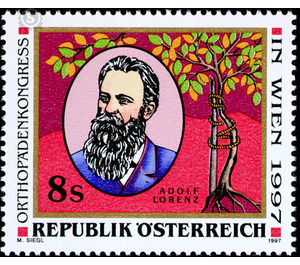congress - Austria / II. Republic of Austria 1997 - 8 Shilling
Theme: Calender
| Country | Austria / II. Republic of Austria |
| Issue Date | 1997 |
| Face Value | 8.00 |
| Color | multi-colored red |
| Printing Type | Photogravure |
| Stamp Type | Commemorative |
| Item Type | Stamp |
| Chronological Issue Number | 1572 |
| Chronological Chapter | OOS-OE2 |
| SID | 658759 |
| In 66 Wishlists | |
The special postage stamp on the occasion of the orthopedic congress (17 to 21 September 1997 in Vienna), shows a portrait of Prof. Adolf Lorenz, founder of the German Society of Orthopedics (1901) and the first Viennese orthopedic school, and a crooked tree that with a Rope is bent to a support post. The tree is based on a work by Nicolas Andry (1658-1742) published in Paris in 1741. According to Andry, the human body consists of the trunk and the outer limbs: the spine is the trunk, the limbs are the branches. Andrys Bäumchen has become a symbol of orthopedics. The Orthopedic Congress 1997 is organized by the German Society for Orthopedics and Traumatology (DGOT) together with the Austrian Society for Orthopedics and Orthopedic Surgery (ÖGO) and the Professional Association of Doctors for Orthopedics in the Vienna Hofburg. Adolf Lorenz was born on 21st April 1854 in Weidenau (Austria-Silesia). Already during his lifetime he had entered the history of medicine as the "father of orthopedics". Adolf Lorenz graduated from the University of Vienna with a doctorate in general medicine and became a surgeon at the I. Surgical Clinic. He began to seek new ways of treatment. A method invented by him based on deformed tissue by manipulation with the hands or treatment with specially invented machines due to normalcy. His motto was: Restoring the function of restoring form. Lorenz was the first physician in Vienna to receive the title of professor for orthopedic services. Thus, the separation from the mother's surgery was initiated. Simplicity and safety marked Lorenz's medical work. For the bloodless treatment new instruments were always necessary, which he brought constantly up to date. Orthopedics according to Lorenz differs from the general surgical procedure in that any orthopedic operation should be harmless, which is not performed for the preservation of life, but only with regard to the beauty. A spectacular hip luxation treatment in the USA made his breakthrough possible and made the name Lorenz known worldwide. The Austrian Society for Orthopedics and Orthopedic Surgery (ÖGO): The ÖGO was founded in 1948. The special field Orthopedics and Orthopedic Surgery covers the detection, prevention and rehabilitation of congenital and acquired deformities and dysfunctions, diseases and injuries of the musculoskeletal system, including related studies and research. ÖGO offers regular courses for those colleagues who can not learn all the specialties of their own department. The training objective is a comprehensive and as homogeneous as possible education for all doctors in training.


